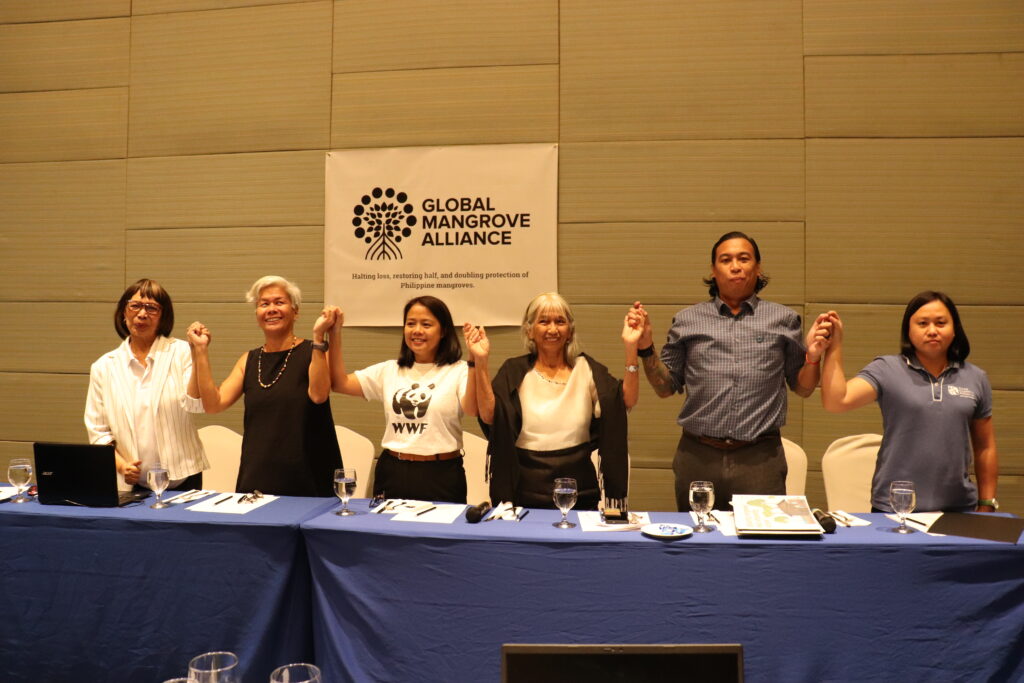
Mangroves ensure food security, not compromise it – GMA Philippines

Restoring mangroves does not threaten food security in the country, but rather ensures it, said the Global Mangrove Alliance Philippines Chapter.
“We want to debunk the misconception that restoring mangroves will threaten food security in the country. Many from the fisheries sector are afraid of losing areas for aquaculture to mangrove restoration. We just want to clarify that mangroves actually enhance aquaculture production, rather than decrease it,” said Dr. Annadel Cabanban, Country Manager of Wetlands International Philippines, Lead Convenor of GMA Philippines.
The Alliance on Tuesday called for the restoration of mangroves in the country through the reversion of abandoned, undeveloped, and underutilized (AUU) fishponds and the establishment of coastal greenbelts.
“For more than a decade, our greatest frustration is the AUU reversion and the establishment of the coastal greenbelt,” said Dr. Jurgenne Primavera, Chief Mangrove Scientific Adviser of the Zoological Society of London Philippines (ZSL-Philippines).
The Alliance says reverting AUU fishponds back to their original mangrove state remains a challenge for mangrove restoration groups due to the lack of list and maps of AUU fishponds.
Having a list and maps of AUU fishponds will help identify areas for conservation, protection, and restoration.
Delays in the guidelines for cancelling fishpond lease agreements (FLAs) also continue to hamper proper assessment of suitable FLA areas for actual reversion.
According to the Alliance, it is misconception that mangroves will impede aquaculture expansion. This hinders relevant agencies and groups from the fisheries sector from cooperating with them in mangrove restoration.
“Promoting aquaculture and mangroves are not contradictory. In fact, science proves that inshore and offshore fisheries are highly dependent on mangroves. So, if we want a vibrant fisheries production, we must give more room for mangroves to create a healthier environment for our sea creatures to multiply,” said Cabanban in a separate interview.
According to the Alliance, mangroves help secure livelihoods and food security for communities, especially since mangroves provide critical home and breeding ground for sea creatures like fish, oysters, crabs, and shrimp.
“The thicker and healthier the mangroves, the greater the habitats that our marine creatures have to breed, nurse, and feed. The reality is that we want to help the fisheries sector by restoring the homes of many of our aquaculture produce,” Cabanban added.
Mangrove loss in the Philippines
Since 1918, the Philippines has lost over 64% of its mangroves, declining from 450,000 hectares in 1918 to 289,350 hectares in 2007, according to a 2011 study by Dr. Maricar Samson and Dr. Rene Rollon.
A large chunk of this loss can be traced back to the conversion of mangroves to aquaculture ponds, showed the study by Dr. Jurgenne Primavera in 2000.
“The loss of mangroves removes the coastal protection that communities enjoy and poses risks not only to their safety, but also to their livelihood,” according to Cabanban.
The degradation of mangrove resources thus prompted the Philippine government to focus on strengthening, implementing, and formulating policies and laws on mangrove protection and rehabilitation.
The Joint DA-DENR General Memorandum Order No. 3 series of 1991 provides for the reversion of AUU fishponds to mangroves.
The Fisheries Code of 1998 likewise establishes coastal resource management as an approach to ensure the sustainability of the country’s coastal and marine resources. This includes the reversion of all AUU fishponds to mangroves.
“The DA-BFAR recognizes the immense value of mangroves in ensuring sustainable fisheries and the well-being of our coastal communities,” said Atty. Demosthenes Escoto, National Director of the Department of Agriculture Bureau of Fisheries and Aquatic Resources (DA-BFAR), in a statement of support sent to GMA Philippines during the launching of the Alliance.
Escoto mentioned a comprehensive mangrove rehabilitation program as one of the criteria in BFAR’s annual Malinis at Masaganang Karagatan (MMK).
“While the Alliance welcomes the statement of support of DA-BFAR’s Director Escoto on mangrove rehabilitation, we want to see such support reflected in reality and on the ground. This means giving us access to the list and maps of AUU fishponds and working with us in mangrove restoration as well as the development of mangrove-friendly aquaculture in the Philippines,” said Cabanban.
About the Global Mangrove Alliance
Established in June 2017, the Global Mangrove Alliance is a global network of non-government organizations, governments, industries, local communities, and funders working together to halt and reverse mangrove loss and double the protection of mangroves worldwide.
On 12 September 2023, the Global Mangrove Alliance Philippines launched as an alliance with the theme “Turning the Tide: Synergies to Accelerate Mangrove Conservation and Halt Loss.”
At present, the members of GMA Philippines are Conservation International Philippines (CI Philippines), Forest Foundation Philippines (FFP), Rare Philippines, Wetlands International Philippines, World Wide Fund for Nature Philippines (WWF Philippines), and Zoological Society of London Philippines (ZSL-Philippines).
